Related Research Articles

In the culinary arts, a spice is any seed, fruit, root, bark, or other plant substance in a form primarily used for flavoring or coloring food. Spices are distinguished from herbs, which are the leaves, flowers, or stems of plants used for flavoring or as a garnish. Spices are sometimes used in medicine, religious rituals, cosmetics, or perfume production. They are usually classified into spices, spice seeds, and herbal categories.For example, vanilla is commonly used as an ingredient in fragrance manufacturing. Plant-based sweeteners such as sugar are not considered spices.

A teaspoon (tsp.) is an item of cutlery. It is a small spoon that can be used to stir a cup of tea or coffee, or as a tool for measuring volume. The size of teaspoons ranges from about 2.5 to 7.3 mL. For cooking purposes and dosing of medicine, a teaspoonful is defined as 5 mL, and standard measuring spoons are used.

Indonesian cuisine is a collection of various regional culinary traditions that formed in the archipelagic nation of Indonesia. There are a wide variety of recipes and cuisines in part because Indonesia is composed of approximately 6,000 populated islands of the total 17,508 in the world's largest archipelago, with more than 1,300 ethnic groups.

Punjabi cuisine is a culinary style originating in the Punjab, a region in the northern part of South Asia, which is now divided in an Indian part to the east and a Pakistani part to the west. This cuisine has a rich tradition of many distinct and local ways of cooking.

Saiful Muluk is a mountainous lake in northern Pakistan, located at the northern end of the Kaghan Valley, near the town of Naran in the Saiful Muluk National Park. At an elevation of 3,224 m above sea level, the lake is located above the tree line, and is one of the highest lakes in Pakistan.
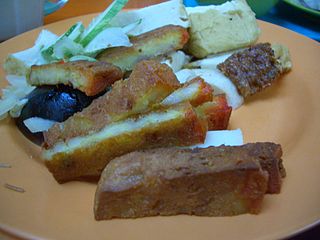
Ngo hiang, also known as heh gernglor bak or kikiam is a unique Hokkien and Teochew dish widely adopted in Indonesia, Malaysia, the Philippines, Singapore, and Thailand; in addition to its place of origin in southern China.

Indian Chinese cuisine, Chinese Indian cuisine, Sino-Indian cuisine, Chindian cuisine, Hakka Chinese or Desi-Chinese cuisine is a distinct style of Chinese cuisine adapted to Indian tastes, combining Chinese foods with Indian flavours and spices. Though Asian cuisines have mixed throughout history throughout Asia, the most popular origin story of the fusion food resides with Chinese labourers of Calcutta, who immigrated to British Raj India looking for work. Opening restaurant businesses in the area, these early Chinese food sellers adapted their culinary styles to suit Indian tastes.
Gulden's is the third largest American manufacturer of mustard, after French's and Grey Poupon. One of the oldest continuously operating mustard brands in the United States, it is now owned by agricultural giant ConAgra Foods.
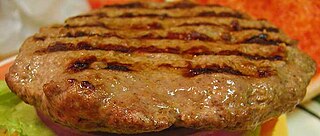
A patty or burger is a flattened, usually round, serving of ground meat or legumes, grains, vegetables, or meat alternatives. Patties are found in multiple cuisines throughout the world.

Shiro, also called shiro wat, or tsebhi shiro, is a stew served for either lunch or dinner, originating from Ethiopia and Eritrea. An essential part of Eritrean and Ethiopian cuisine, its primary ingredient is powdered chickpeas or broad bean meal and often prepared with the addition of minced onions, garlic and, depending upon regional variation, ground ginger or chopped tomatoes and chili-peppers. Shiro is served atop injera or kitcha. Tegabino shiro is a type of shiro made from heavily spiced legume, chickpea, field pea, or fava bean, oil, and water. It is brought bubbling to the table in a miniature clay pot or shallow aluminum pan. It is often consumed with dark or sergegna injera.
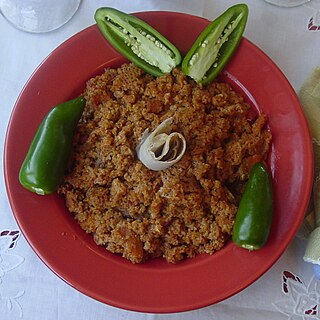
Fit-fit or fir-fir, , is an Eritrean and Ethiopian food typically served as breakfast. Fit-fit is served by preparing sauce and shredding injera or kitcha into pieces and mixing the two. It is generally made with shredded flat bread, spiced clarified butter, and the hot spice berbere. There are two main varieties of fit-fit depending on the type of flatbread being used: the sourdough injera and the unleavened kitcha.

Mizrahi Jewish cuisine is an assortment of cooking traditions that developed among the Jews of the Middle East, North Africa, Asia, and Arab countries. Mizrahi Jews have also been known as Oriental Jews.

Omani cuisine is part of the Khaleeji cuisine and is influenced by Arab, Pakistani cuisine, Iranian, Indian, Asian, Eastern Mediterranean, and African cuisine, reflecting Oman's position as a vast trading empire at the intersection of traditional spice trade routes. Dishes are often based on chicken, fish, and lamb, as well as the staple of rice. Most Omani dishes tend to contain a rich mixture of spices, herbs, and marinades. Omani cuisine differs from other cuisines in the Arabian peninsula, as it is less spicy and seldom served warm.
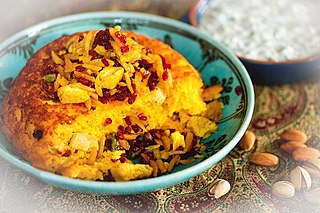
Tahchin is an Iranian rice dish primarily consisting of rice, yogurt, saffron, eggs and finally barberries are sprinkled on top. Some versions of the dish are more elaborate, folding in chicken fillets, vegetables, fish, or red meat.
Mohammad Asif was an Afghan field hockey player, who competed at the 1936 Summer Olympic Games and played in both of his team's games. He was a member of Afghanistan's royal Durrani dynasty and held the title of shazada.
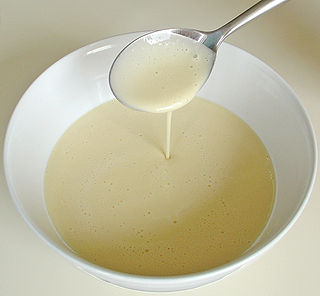
Batter is a flour mixture with liquid and other ingredients such as sugar, salt, and leavening used for cooking. It usually contains more liquid than dough, which is also a mixture of flour and liquid. Batters are usually a pourable consistency that cannot be kneaded. The batter is most often used for pancakes, light cakes, and as a coating for fried foods. It is also used for a variety of batter breads.
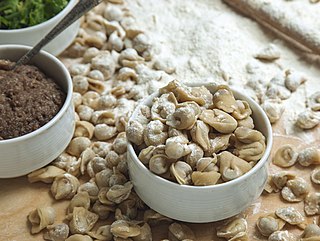
Joshpara is a kind of dumpling popular in Central Asia, South Caucasus and the Middle East. They are made of unleavened wheat dough squares filled with ground meat and condiments. In observance of the Islamic dietary rules, the meat filling is usually without pork.
Malook Nagar is an Indian politician and businessman who is a Member of Parliament in the 17th Lok Sabha from Bijnor. He unsuccessfully contested Meerut and Bijnor Lok Sabha constituencies of Uttar Pradesh in 2009 and 2014 respectively as a candidate of the Bahujan Samaj Party.

Nasi gandul or in Javanese sega gandhul is a rice dish served in rich, sweet, savoury and spicy beef soup, specialty of Pati Regency, Central Java, Indonesia. Nasi gandul consists of steamed rice topped with slices of beef served in spicy soup with savoury flavour in golden-brownish colour. Nasi gandul is somewhat quite similar to other Indonesian dishes; beef semur, tongseng and Javanese gulai.
References
- ↑ Sports-Reference Profile
- ↑ "Tahdig – Saffron-Crust Rice in the Persian Manner — Silk Route food memoir by Shayma Saadat – The Spice Spoon". www.thespicespoon.com. Retrieved 7 October 2020.